Replaces
2007 Lincoln Mark LT 4 Wheel Drive Front 4 Piece Drivetrain Kit TRQ CSA64062
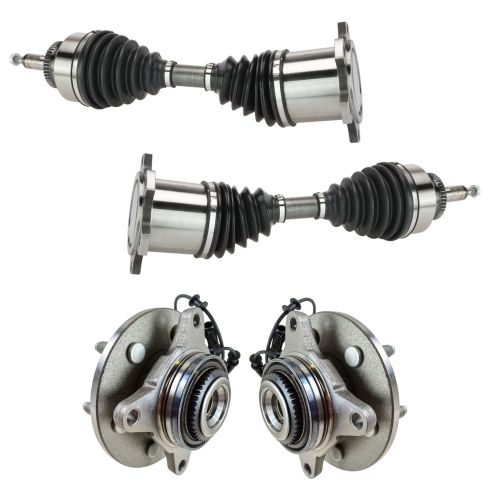



CSA64062
This part doesn’t fit a . Select from parts that fit.
Specify your vehicle's year, make and model to guarantee fit.
This part doesn't fit a . Select from parts that fit.
Buy in the next and
Orders must be placed by 2pm ET
Recommended for your 2007 Lincoln Mark LT
You may also like
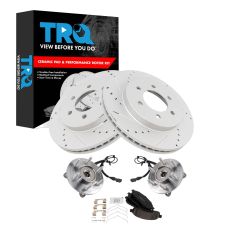
Ceramic Performance Brake Pad & Rotor Kit with Wheel Bearings
$397.95
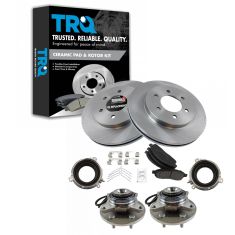
Ceramic Brake Pad & Rotor Kit with Wheel Bearings
$424.95
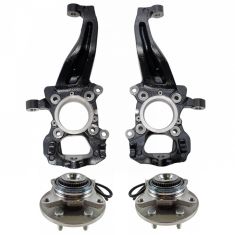
4 Piece Suspension Knuckle Kit
$425.95
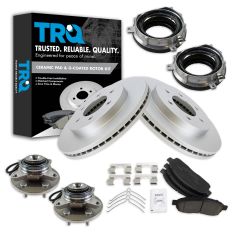
Ceramic Brake Pad & Rotor Kit with Wheel Bearings
$444.95

Ceramic Performance Brake Pad & Rotor Kit with Wheel Bearings
$496.95

6 Piece Suspension Knuckle Kit
$534.95
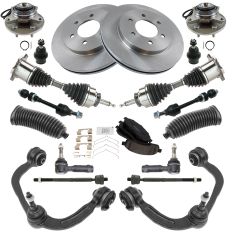
Ceramic 19 Piece Steering, Suspension, & Brake Kit
$714.95
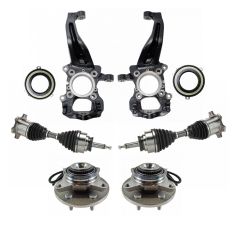
Drivetrain Kit
$729.95
Part Details
- (2) Front CV Axle Assemblies
- (2) Front Wheel Bearing & Hub Assemblies
- Tapered Roller Bearing
- 4 Piece
Specifications
- 4 Wheel Drive
- Front
About TRQ:
TRQ is a trusted brand dedicated to making every repair a success story by combining premium parts with easy installation. Each TRQ part is engineered by a team of automotive experts to meet or exceed OEM standards, delivering enhanced performance and maximum longevity. With rigorous in-house testing, the brand ensures superior fit and function across every product line. TRQ also provides customers with best-in-class, step-by-step installation videos—so you can complete repairs with confidence, whether you're a first-time DIYer or an industry professional.
Product Features
What are Tapered Bearings and Why Use Them? Tapered bearings use rollers shaped like flat-topped cones and two races angled from the outside in of the bearing. This angle makes the bearing better at handling forces exerted on the bearing during cornering (known as axial load) in trucks and large cars. Your model came from the factory with tapered bearings. Roller ball bearings work well for smaller cars, but replacing a tapered bearing with a roller ball bearing increases wear and failure.
TRQ drivetrain kits are manufactured using premium raw materials to restore original performance. Each TRQ drivetrain component is designed to be a direct, maintenance-free replacement to the stock unit. To extend the service life of your drivetrain, TRQ recommends replacing wheel hubs, bearings, and constant velocity (CV) drive axles at the same time to ensure even wear of components and improved ride comfort. All products are fit and road-tested in our Massachusetts R&D facility to ensure we deliver on our promise of Trusted Reliable Quality.
CV axles are designed to transmit the power from your vehicle's drivetrain to the wheels while being able to flex and pivot to the demands of the steering and suspension systems. If your vehicle is making clicking noises at lower speeds or when making turns, it may be time to replace your CV axles with our 100% brand new assemblies.
Our steering and suspension components are pre-greased and sealed for long life and do not require the extra maintenance typically required by greaseable versions.
Attention California Customers:
![]() WARNING: This product can expose you to chemicals including Lead and Lead Compounds, which are known to the State of California to cause cancer, and birth defects or other reproductive harm. For more information, go to www.P65Warnings.ca.gov.
WARNING: This product can expose you to chemicals including Lead and Lead Compounds, which are known to the State of California to cause cancer, and birth defects or other reproductive harm. For more information, go to www.P65Warnings.ca.gov.
Lifetime Warranty
This item is backed by our limited lifetime warranty. In the event that this item should fail due to manufacturing defects during intended use, we will replace the part free of charge. This warranty covers the cost of the part only.
FREE Shipping is standard on orders shipped to the lower 48 States (Contiguous United States). Standard shipping charges apply to Hawaii and Alaska.
Shipping is not available to a P.O. Box, APO/FPO/DPO addresses, US Territories, or Canada for this item.
Expedited is available on checkout to the United States, excluding Alaska, Hawaii.
Final shipping costs are available at checkout.






Created on:
Tools used
- Tapered rollers shaped like flat top cones provide more contact area, which increases their capability at receiving forces excreted by trucks and large cars. Ball bearings are good for small cars as they do not need to sustain as much weight as the tapered roller bearings.
Hi everyone. Sue here at 1A Auto, and today we're gonna talk bearings. The difference between a roller bearing and a ball bearing type.
While both a roller bearing and tapered bearings work in the same manner. Tapered bearings use tapered rollers shaped like flat topped cones and two races angled from the outside to the inside of the bearing. The rollers have a large contact area which is what makes them better than roller bearings at handling forces exerted on the bearing during cornering in trucks and large cars.
For applications that require it, the TRQ brand offers tapered roller bearing style wheel bearings that match OEM specifications where other brands do not.
Roller ball bearings work well for small cars but replacing a tapered bearing with a roller ball bearing will result in increasing wear and faster failure.
So now that you know all parts aren't created equal, you can purchase your TRQ bearing at 1aauto.com.
Tools used
- Pry off the center cap with a flat blade screwdriver Loosen the 21mm lug nuts with the vehicle on the ground Remove the hub cap with pliers Loosen the 13mm nut Raise the vehicle with a floor jack Secure the vehicle on jack stands Remove the lug nuts Pull off the wheel
- Pry the brake pads into the caliper with a flat blade screwdriver to push in the pistons Remove the 13mm bolts from the brake caliper Pull the caliper aside Pry the brake pads off with a flat blade screwdriver
- Remove the 18mm bolts from the brake caliper bracket Pull off the brake caliper bracket Thread a nut onto the rotor Hit the rotor with a hammer Pull the rotor off
- Disconnect the ABS harness sensor Remove the ABS from the harness on the bracket Remove the four 18mm bolts from the hub Remove the 13mm hub nut, making sure you can push the nut in and out Twist in an 18mm bolt to the hub Remove the hub
- Grease the set of bearings inside the new hub with bearing grease Apply a light coat of bearing grease to the engaging wheel for the 4WD Insert the hub into place Tighten the 18mm bolts to the hub Tighten the 18mm bolts to 95 foot-pounds of torque Replace and tighten the 13mm hub nut Tighten the 13mm bolt to 20 foot-pounds of torque Push the ABS wire into its respective brackets Replace the hub cap
- Slide the rotor on Thread on one lug nut to hold the rotor in place Adjust the emergency brake, if necessary Put the bracket back into place Start the 18mm bolts by hand Tighten the bolts to 95 foot-pounds of torque
- Put the caliper on Thread the 13mm bolts by hand Tighten bolts to 25 foot-pounds Remove the lug nut from the rotor
- Slide the wheel into place Start the lug nuts by hand Tighten the lug nuts preliminarily Lower the vehicle to the ground Tighten the lug nuts to between 110 foot-pounds in a crossing or star pattern Reattach the center cap Connect the ABS sensor
- Pump your brakes repeatedly until they feel firm Test your brakes at 5 miles per hour and then 10 miles per hour Road test the vehicle
Brought to you by 1AAuto.com, your source for quality replacement parts and the best service on the Internet.
Hi, I'm Mike from 1A Auto. I hope this how-to video helps you out, and next time you need parts for your vehicle, think of 1AAuto.com. Thanks!
In this video, we're going to show you how to replace a front hub on this 2005 Ford F150. We show you on the passenger side but the driver's side is the same procedure. The items you'll need for this are a new front hub from 1AAuto.com, a 13mm, 18mm, and 21mm socket and ratchet with a piece of pipe for leverage, flat blade screwdriver, a pair of pliers, a jack and jack stands and a torque wrench.
Pry off the hubcap, and then, using your 21mm socket and ratchet, loosen up each of the lug nuts. Pull off this cap with a pair of pliers and then loosen up this 13mm nut. Now raise the vehicle and remove the lug nuts the rest of the way. Remove your wheel.
Turn the wheel so you can access the brakes better. To make it easier to get the caliper off, just take a large screwdriver and put it into the brake disk and pry out. You don't have to move it far, just enough to help you get things apart. Then we are going to remove the two 13mm bolts here and one up here. Push in the slides on the bracket and then pull the caliper up and off.
Now pry out your brake pads and now remove these two 18mm bolts on the back of your caliper bracket, and we'll just fast-forward as Mike removes those. Put one of the lug nuts back on and then tap your rotor. Then remove the lug nut and pull your rotor free.
The ABS harness connector is under the hood but actually it's easier to reach it from underneath. You can see I'm reaching up through the inner fender and pressing on the tab and pulling it apart. It does take a little bit of force but you can get it. If everything here is wire-tied, make sure you disconnect that, and then just pull this clip out at the top of this harness. Then you want to remove these four 18mm bolts. Two on that side and two over here. We'll fast-forward as Mike removes both of those, and you can see he uses a piece of pipe for some extra leverage.
Now remove that 13mm nut the rest of the way, and you want to make sure that it can push in and out. That means your axle is going to disconnect from the hub. Now twist in one of those 18mm bolts just a partial way so this doesn't go flying when you hammer it. You just want to hammer it to loosen it up a bit more from the wheel knuckle, then remove that bolt, and your hub should pull free.
On the right is the old hub; on the left is the new one from 1A Auto. You can see they are identical and they'll fit exactly the same. Here is a front shot. You can see same thing, they look identical. Just wipe any dirt off of there or anything. Grease up the set of bearings that's right inside here with some bearing grease. Then just apply a light coat to the engaging wheel for the 4-wheel drive here. That harness lead faces the back. Get it in place. We'll fast-forward as Mike replaces the rest of those bolts and then tightens all of them up. You want to torque each of those four bolts to 95 foot-pounds.
Now replace that 13mm nut, tighten it up, and then just torque that to 20 foot-pounds. Take your ABS wire and unclip it. Then you want to just push this into that bracket right there. Replace this small cap.
Put the rotor into place, and then replace a lug nut to just hold it in place while you put the caliper bracket back on. You put the brake caliper bracket back into place and replace the two 18mm bolts that hold it there. We'll fast-forward as he tightens those up. Then you want to torque both of those to 95 foot-pounds.
Put your caliper back into place. Then replace those two 13mm bolts and tighten them up. Now torque both of these to 25 foot-pounds. Reconnect this clip on the ABS harness. Just work your way down the harness, re-clipping the end to each of those clips.
Remove the lug nut and then put your wheel back into place. Then replace each of the lug nuts and tighten them up preliminarily. Then lower the vehicle and tighten them the rest of the way. Torque each of the lug nuts to 110 foot-pounds in a crossing pattern. Replace your hubcap.
Come up here and reconnect your ABS harness. After doing any work on the brakes, you just want to pump the brake pedal until it firms up. Then do a stopping test from 5 miles per hour, then 10 miles per hour. We hope this video helps you out.
We hope this video helps you out. Brought to you by www.1AAuto.com, your source for quality replacement parts and the best service on the Internet. Please feel free to call us toll-free, 888-844-3393. We're the company that's here for you on the Internet and in person.
Tools used
- Pry off the center cap with a flat blade screwdriver Pull off the hub dust cover with pliers Remove the 13mm axle nut Have an assistant hold the tire or press the brakes Remove the six 12-point, 12mm bolts that hold the CV axle to the solid axle
- Remove the 30mm nut bolt from the bottom of the strut Tap the 30mm bolt out with a hammer Pry the strut aside with a pry bar
- Pull the CV axle past the solid axle Pull the CV axle out of the wheel hub Pull the CV axle out past the solid axle
- Slide the CV Axle into position Slide the CV Axle into the wheel hub
- Pry the strut into the lower control arm Fasten the 30mm nut and bolt onto the bottom of the strut Tighten the 30mm nut and bolt to between 95 to 100 foot-pounds of torque
- Line up the CV axle with the solid axle Insert the six 12-point, 12mm bolts into the CV Axle Tighten the 12mm bolts to 25 foot-pounds in a crossing or star pattern Fasten the 13mm nut onto the end of the axle Tap on the dust cover with a hammer Push on the center cap
Brought to you by 1AAuto.com, your source for quality replacement parts and the best service on the Internet.
Hi, I'm Don from 1A Auto. I hope this how-to video helps you out, and next time you need parts for your vehicle, think of 1AAuto.com. Thanks.
In this video, we're going to show you how to replace a front axle on this 2004 Ford F150. It's pretty much the same for any 2004 to 2010. This is a 4 wheel drive. You're going to need new axles from 1AAuto.com. We show you the right hand or passenger side axle; the left hand driver's side axle is the same procedure. You'll also need jack and jack stands; pry bar; pliers; 13, 24, and 30 millimeter sockets; a ratchet and a breaker bar; a pipe for some leverage; a 12 millimeter, 12 point socket and ratchet; and a torque wrench.
To start out, raise and support the vehicle securely and then remove your center cap. We remove the cap on the end of the hub. With a 13 millimeter socket, I remove the nut on the end of the axle. Where the end of your CV joint meets the solid axle, there's going to be six 12-point, 12 millimeter bolts. I'm using a 12-point socket to remove those. We're just going to do some fast forwarding here, and you can basically hold on to the tire, or you could have somebody hold the brakes for the vehicle. Loosen up those bolts and remove them. I'm going to remove the bolt with a 30 millimeter socket that holds in the lower part of the strut assembly, so that we can get more room to pull the CV shaft out. I'm going to fast forward here as we remove that nut and bolt. Once you get the nut loosened up you can tap it with a hammer a few times, and make sure that the bolt is loose and will come out. I'm going to use a pry bar and pry out the lower end of the strut assembly from the lower control arm. While I was prying on the lower part of the strut assembly I was able to pull the CV shaft past this. Now I'm going to pull the shaft out. Okay, and we'll just speed up here. Work the axle out and then you actually have to work the lower strut mount out. You can see we'll use a pry bar, and get that moved out of the way and then the axle comes right out.
I'm sliding the CV joint back into place. Now, with the wheel all the way turned out I'm going to go ahead and rescecure where the strut goes into the lower control arm. Then once you get that back in place use the bolt or you can also use a screw driver or a lineup tool, get the hole to line up, get the bolt through, put the nut on the back side, and then tighten it up. You want to tighten that bolt up to about 95 to 100 foot pounds. I'm going to line up the holes on the CV shaft with the solid axle and reinstall the 12 millimeter, 12-point bolts. Once again, we'll fast forward here. We install the bolts first by hand. Make sure they're turning in there and you're not cross-starting any of the bolts. Then tighten them up kind of preliminarily. Then what you want to do is use a cross pattern. Tighten one up, and you want to tighten them to about 25 foot pounds. Tighten one up and then, go to the opposite one, tighten that one up, and just keep with that pattern until they're all tight.
I'm reinstalling the 13 millimeter nut on the end of the axle, CV shaft. Reinstall the cap, and align your center hub cover, the pin here and the hole there.
We hope this video helps you out. Brought to you by www.1AAuto.com, your source for quality replacement parts and the best service on the Internet. Please feel free to call us toll-free, 888-844-3393. We're the company that's here for you on the Internet and in person.
Tools used
- Pry off the center cap with a flat blade screwdriver Loosen the 21mm lug nuts with the vehicle on the ground Raise the vehicle with a floor jack Secure the vehicle on jack stands Remove the lug nuts Pull off the wheel
- Turn the wheel Remove the 21mm nut from the outer tie rod Leave the 21mm nut on a couple threads Hammer the knuckle until the outer tie rod loosens Set the outer tie rod off to the side
- Remove the hub nut cap with a pair of pliers Remove the 13mm hub nut Replace the 13mm nut by a few threads and tap the nut with a hammer to push the axle through Remove the nut Have an assistant hold the brakes Remove the 12mm bolts from the axle with a 12mm 12-point socket
- Remove the 21mm nut from the bottom of the upper control arm Thread the 21mm nut on Loosen the upper control arm with a hammer Remove the nut Manuever the wheel knuckle to the side without straining the brake lines Remove the axle from the wheel knuckle
- Insert the axle into place Insert the upper control arm into the wheel knuckle Tighten the 21mm nut Tighten the 12mm bolts into the axle Torque the 12mm nuts to 60 foot-pounds in a crossing pattern Tighten 13mm hub nut Torque the hub nut to 20 foot-pounds Tap the hub nut cap into place Re-clip and realign any lines that may have come undone
- Push the outer tie-rod up through the wheel knuckle Replace the 21mm nut Torque the 21mm nut to 111 foot-pounds Tighten the bolt on the upper control arm Torque the upper control arm 21mm nut to 111 foot-pounds Tighten the 18mm nut to the sway bar link Jack underneath the control arm Torque the lower strut bolt to 150 foot-pounds
- Slide the wheel into place Start the lug nuts by hand Tighten the lug nuts preliminarily Lower the vehicle to the ground Tighten the lug nuts to 120 foot-pounds in a crossing or star pattern Reattach the center cap
Brought to you by 1AAuto.com, your source for quality replacement parts and the best service on the Internet.
Hi, I'm Mike from 1A Auto. I hope this how-to video helps you out, and next time you need parts for your vehicle, think of 1AAuto.com. Thanks.
In this video, we're going to show you how to replace a front axle on this 2005 Ford F-150 with 4-wheel drive. We show you on the driver side, but the passenger side is the same procedure. The items you'll need for this is a new front axle from 1AAuto.com, an 8mm, 13mm, and 21mm socket and ratchet, a piece of pipe for some extra leverage, a 12mm 12-point socket, an 18mm and 21mm wrench, pliers, pry bar, hammer, torque wrench, and jack and jack stands.
Start off by prying off the hub cap. Then loosen up these lug nuts using a 21mm socket and ratchet and a piece of pipe for some extra leverage. Once you get each of them loosened up, you can raise the vehicle and remove them the rest of the way. Now pull the wheel off.
Turn the wheel and then remove this 21mm nut at the top of your outer tie rod. Once you remove it, you want to just put it back on just a couple threads. Now hammer the knuckle until the outer tie rod drops down. Now you can remove that nut, and just set your outer tie rod off to the side.
Using a pair of pliers remove this cap and then loosen up and remove that 13mm nut. Then you just want to put it back on, just a few threads, tap it with a hammer and make sure it goes through. Then remove the nut the rest of the way. On the other end of the axle there's a series of 12mm bolts. You just need to use a 12mm 12-point socket and then a pry bar to hold the wheel and just loosen those up. We'll fast-forward as Mike removes all six of those. When you remove that last one, just push the axle down to the side.
Now spray this 21mm nut up here on the bottom of your upper control arm, and then remove that nut and put it back on just a few threads. With the nut back on a few threads, just hammer the wheel knuckle until the upper control arm loosens up. Now just lift up on the wheel knuckle and then remove that nut. You can just set the wheel knuckle off to the side carefully. You don't want it to strain those brake hoses. Then just tap the axle and pull it out of the wheel knuckle. You want to feed the axle towards the left side, towards the front of the vehicle. Just angle it down and pull it down and out.
On the bottom is the old front axle; above it is the new one from 1A Auto. You can see they're identical and they'll fit exactly the same. Making sure they're tightened. Now you can remove the jack and feed your axle back into place. You want to feed it back in the same way that you pulled it out.
Now you can take your upper control arm and push it back into the wheel knuckle. Once you push it through, just put that 21mm nut on there to hold it in place. Line up the axle and replace those 12mm bolts. We'll fast-forward as Mike does this. Now tighten each of those to 60 foot-pounds in a crossing pattern. You can see we torqued that one. Then you want to turn the wheel until you get the one on the opposite side. Then torque that one. You want to just repeat this process with each of them. Now replace this 13mm nut and torque it to 20 foot-pounds. Then replace that cap and just tap it into place.
If any of the lines on the back came undone, make sure you push them back in and re-clip them. Then push your outer tire rod up to the wheel knuckle and replace the nut. Then torque that to 111 foot-pounds. Now just tighten up this bolt on your upper control arm. If the stud spins, use a 10mm socket and ratchet. Then you want to torque this to 111 foot-pounds. Then tighten up the nut on the bottom of your sway bar link. Jack up underneath the lower control arm to simulate a wheel being in place. Torque the lower strut bolt to 150 foot-pounds.
Now we'll fast-forward as Mike replaces the wheel and replaces the lug nuts and tightens them preliminarily. Then he lowers the vehicle and tightens them the rest of the way. Then torque each of them in a crossing pattern to 120 foot-pounds. Then just replace your hubcap and you're all set.
We hope this video helps you out. Brought to you by www.1AAuto.com, your source for quality replacement parts and the best service on the Internet. Please feel free to call us toll-free, 888-844-3393. We're the company that's here for you on the Internet and in person.
Tools used
- Remove the center hub cap with a pair of pliers Remove the 13mm axle nut Loosen the 19mm lug nuts with the vehicle on the ground Raise the vehicle with a floor jack Secure the vehicle on jack stands Pull off the hub cap Remove the lug nuts Pull off the wheel
- Have an assistant hold the brake pedal Remove the six 12 point, 12mm bolts from the axle flange Remove the 30mm nut at the bottom strut bolt Pry out from under the strut Remove the axle
- Insert the CV axle into place without tearing the boot or dislocating the joints Put the strut into place Tighten the 30mm bolt to the bottom strut Have an assistant hold the brake pedal Tighten the six 12-point, 12mm bolts to the axle flange
- Slide the wheel into place Start the lug nuts by hand Tighten the lug nuts preliminarily Reinstall the axle nut preliminarily Lower the vehicle to the ground Tighten the axle nut Reinstall the axle nut cap Tighten the lug nuts 150 foot-pounds in a crossing or star pattern
Brought to you by 1AAuto.com, your source for quality replacement parts and the best service on the Internet.
Hi, I'm Mike from 1A Auto. I hope this how-to video helps you out, and next time you need parts for your vehicle, think of 1AAuto.com. Thanks!
In this video, we're going to be working with our 2004 Ford F150. We're going to show you how to remove and replace the front CV axle. We are doing this on the driver's side, but this part and information is going to be the same on the passenger's side.
If you like this video, please click subscribe. We have a ton more information on this truck, as well as many other makes and models. If you need this part for your vehicle, you can follow the link down in the description over to 1AAuto.com.
Here are the items you'll need for this repair: 12mm-30mm sockets, wrenches, socket extension, 12-point 12mm socket, pliers, prybar/breaker bar, torque wrench, flat blade screwdriver, rust penetrant, jack, and jack stands.
Using a pair of pliers, wiggle the cap out of the center of the hub and remove this thirteen millimeter nut at the end of the axle. Break the lug nuts loose with a nineteen millimeter socket and a breaker bar. You only want to crack them loose about one turn. We're going to do this on a lift to make it easier to show you, but this job can be done at home on a jack and jack stand. Once we've loosened the wheel and the axle nut, we'll raise and support our vehicle. Finish removing the lug nuts and remove the wheel and tire from the truck.
We'll remove these six, twelve-point 12 millimeter bolts with a twelve-point socket and ratchet so we can disconnect the axle flange from the differential. You'll need a friend to get inside the vehicle and hold the breaks as you break the bolts loose. We'll rotate it. Remove each one as the get on and off the brakes.
We've soaked all of our hardware in penetrating oil before starting here because these flanges tend to get pretty rusty. This is not somewhere you want to break off a bolt. Have your assistant release the brake pedal. Rotate the axle around a hundred and eighty degrees. Have them reengage the pedal so you can finish removing the hardware. Using a 30 millimeter socket, remove these nuts at the bottom strut bolt. You may have to support the bolt side with a twenty seven millimeter wrench. Remove the nut and bolt.
We've cut the wheel all the way to the left to allow more room. Now, we can pry out from under our strut. Pull it out to the side. Easily remove our axle from the truck. This will take a little bit of work. You're going to have to move it a little. Fight it. You may need a pry bar or a hammer to work it out. Sometimes, they do just come out easily.
Here, we have our old CV axle that we removed from our truck and our new part from 1AAuto.com. As you can see, these parts are nearly identical. We have the same shaft at the end, same threads, and it comes with the new nut. We have the teeth to lock into our hub. Same six bolt flange at the far end. The shafts are a little bit shorter in the center. But, the overall length of the axle is the same. That's what matters here. These boots just come out a little bit farther. These ones here are all torn up and broken. You can see the end cap blew out and let the grease and barrings out of the other end of our CV axle during removal.
CV axles are prone to clicking when taking sharp turns. Most noticeable when the vehicle is in four-wheel drive. But, even when this is turning with the hub and you get it to a steep angle, when you turn the car, it will make a clicking sound. If your CV axle is blown out, making noise, or has snapped and failed completely, preventing your vehicle from going into four wheel drive and moving around underneath the truck, potentially damaging some other components.
This new part from 1AAuto is going to go in, direct fit, just like your original equipment and fix you up right.
Reinstall the CV axle, being careful not to dislocate either of the joints or tear the boot. Put the strut back into place. To reinstall the bottom strut bolt, we're actually just a little bit out of line here. We're going to take a pry bar, put it through this notch in the bottom of the control arm, and push up just a little so our bolt slides in easily. We'll straighten out our wheel. Spin the nut back on by hand. Finish tightening it down with a thirty millimeter socket and ratchet and a twenty seven millimeter wrench to hold the bolt on the other side.
Line up the flange at the rear of the CV axle. Reinstall your twelve-point, twelve millimeter bolts. Get these in as far as you can by hand. Then you'll need your assistant again to work the breaks while you tighten them down with a socket and ratchet.
Reinstall the wheel and tire. Start your six lug nuts by hand. Reinstall that thirteen millimeter nut on to our axle as far as we can. Then put our vehicle back on the ground. Tighten down the axle nut with a thirteen millimeter socket and ratchet. Reinstall the dust cap over the axle nut. Tap it back into place. You can use a rubber mallet or a piece of wood on a hammer. I'm just using the end of the ratchet here because it's handy. Torque the lug nuts to 150 foot pounds. It's very important when torqueing six lug wheels. The cross pattern is different from your standard five lug wheel. You want to make little triangles. We'll skip one lug and, tighten the first three. Then, we'll go across, skip one, skip one again. We'll be tightening the wheels in two small triangles.
Thanks for tuning in. We hope this video helped you out. Next time you need parts for your car, please visit 1AAuto.com. Also check out our other helpful how-to and diagnosis videos.

CSA64062
877-844-3393
Monday - Friday 8:00am - 9:30pm ET
Saturday - Sunday 8:00am - 4:30pm ET
Specify your vehicle's year, make and model to guarantee fit.
This part doesn't fit a . Select from parts that fit.








